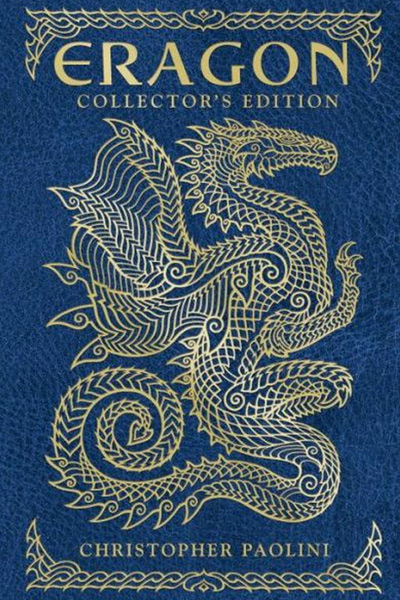Paolini’s Eragon Revisited 10 Years Later
It’s hard to believe it’s been 10 years since the publication of Eragon, the debut novel from then-wunderkind teen writer Christopher Paolini, about a farm boy who discovers a dragon’s egg and becomes a reluctant hero. It was a highly controversial release back in 2003: although it sold phenomenally well (it was the third best-selling children’s novel that year, behind J.K. Rowling’s Harry Potter and the Order of the Phoenix and Lemony Snicket’s The Slippery Slope), critics lambasted Paolini’s storyline for being too derivative.
Admittedly, back in 2003, I agreed to some extent. Though I found Eragon entertaining, I could see where the storyline was “inspired” by classic sagas like J.R.R. Tolkien’s The Lord of the Rings, Anne McCaffrey’s Pern series, and Ursula Le Guin’s Earthsea Trilogy.
But recently Knopf released Eragon: The Collector’s Edition, a visually stunning 10th anniversary faux-leather bound edition featuring a new introduction from Paolini as well as full-color illustrations by iconic artists such as John Jude Palencar, Donato Giancola, and Michael Hague (plus an illustration by Paolini himself!). I decided to reread this contentious book, to see if my experience would be the same as when I first read it back in 2003.
It wasn’t. The second time around was markedly more enjoyable than the first. I’ve thought about the reasons why I enjoyed Eragon so much more ten years after the first reading, and I’ve come up with a few revelations:
1. Yes, the storyline of Eragon draws comparisons to some fantasy classics. Yes, some elements could be considered derivative. But the reality is that many fantasy novels can be considered derivative in some way. As a critic who has reviewed more than 6,000 titles over the last 20 years, I can say that it’s exceedingly rare to come across a novel that I consider truly original or innovative.
2. Eragon was written when Paolini was a teenager, presumably as an adventure for young readers. I think back in 2003—during the height of Potter mania—readers, consciously or not, compared books like Eragon to Potter’s adventures, and inevitably came away disappointed. Although Eragon certainly explored weighty themes like honor, friendship, responsibility, and forgiveness, it didn’t have the narrative complexity, thematic depth, and age-transcendent appeal of Rowling’s saga. Lost in these unfair comparisons is the amazing fact that Paolini began writing this story at the age of 15, self-published it when he was 18, and sold millions before he could legally drink!
3. Eragon is a powerful read that has obviously resonated with countless readers, young and old. I remember when I was that same age, reading Le Guin’s A Wizard of Earthsea for the first time and being blown away. The Earthsea trilogy was a landmark read for me, and I know that Eragon holds that same significance for millions of readers around the world. So even if bald old book reviewers like myself see comparisons to older fantasy works in Eragon, does it ultimately matter? If a young boy or girl reads it and thoroughly enjoys their time in the fantasy realm of Alagaësia, then Paolini has succeeded.
The inarguable fact is that Eragon is not only a historically significant novel, but one that’s been treasured by millions of readers—and will continue to be treasured as new readers discover it year after year.
Have you read the Eragon books?
